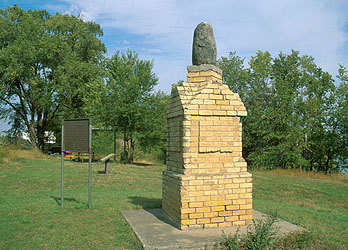The lands of the Standing Rock Reservation were created by the Act of 2 March 1889. The Standing Rock Sioux Tribe is made up of decendants of Hunkpapa and Blackfeet bands of the Teton Division of the Lakota Nation on the South Dakota side, and Hunkpatinas and Cuthead bands of the Yankton Division of the Dakota Nation on the North Dakota side of the Reservation.
As I understand it, the legend of Standing Rock goes something like this:
A Dakota man married an Arikara woman, and had one child with her. Later, he took another wife. The first wife was jealous and pouted. When the time came for the village to break camp she refused to move from her place inside her tipi. The tipi was taken down, but she continued to sit on the ground with her baby in a cradleboard on her back. Her husband and the rest of the band finally moved without her.
At mid-day the Dakota man could go no further and stopped the procession of the camp and said to his two brothers, "Go back to your sister. Tell her to come on and we will wait for you here. But be quick, for I am concerned she may become desperate and kill herself."
The two brothers rode off and arrived at their former camping place by that evening. The Arikara woman still sat on the ground. The elder brother spoke saying, "Sister, get up. We have come for you. The village is waiting for you."
She did not answer, and he put out his hand and touched her head, but found she had turned to stone.
The two brothers lashed their horses and came back to where the camp had stopped. They told their story, but were not believed.
"My first wife has killed herself and my brothers will not tell me," said the husband.
However, the whole village broke camp and came back to the place where they had left the Arikara woman. Sure enough, she sat motionless, a block of stone.
The camp was very excited by this unusual thing that happened and so they chose a horse, made a new travois and placed the stone on it. The horse and travois were beautifully painted and decorated, as the stone was thought to be
Waka'n (holy or sacred). When the band stopped to make a new village site, the stone was given a place of honor in the center of the camp.
Whenever the camp moved the stone and travois were taken along. The stone woman was carried like this for years, and finally brought to Standing Rock Agency, and now rests upon a brick pedestal in front of the agency office at Fort Yates, North Dakota.

As far as the Lakota name for "Standing Rock," the proper name in Lakota would be
In'yan Wosla'ta Han.
In'yan is the term for "rock" or "stone".
Wosla'ta is the term for "erect" or "perpendicular" or "vertical" or "on end" which is derived from
Wosla' meaning "upright" or "straight up".
Han is the term used with inanimate objects meaning "to stand".
Therefore,
In'yan Wosla'ta Han translates as "Stone Standing Erect" or "Standing Rock". Often the
Han part is left off as it is a more formal translation, and some consider it redundant.
Note:
Na'zin means "to stand" when taking about animate objects.